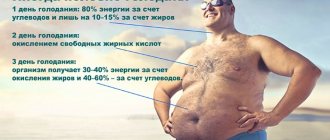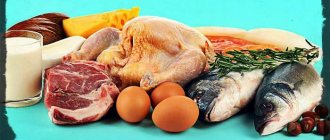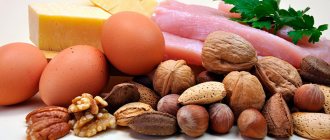General information
For those who want to feel more alert and healthy, as well as get rid of extra pounds, modern doctors and adherents of alternative medicine offer many different techniques. One of them is water fasting , which is also called wet fasting.
Water fasting is a process when a person refuses to consume any food for a long time, but at the same time drinks water in unlimited quantities. There is still debate about how effective this method is and the benefits of water fasting. But numerous reviews indicate that with the right approach to this process you can get tangible benefits. How to fast on water correctly, what are the benefits and harms of this method and what results can be obtained by abstaining from food will be discussed in this article.
Negative and positive reviews about fasting
Even in ancient times, people knew about the absolute benefits of fasting on water. Doctors and specialists have studied and continue to study the mechanisms of this method. Considerable experience has been accumulated in using this diet to get rid of certain diseases and to normalize body weight. Judging by the reviews of people who have tried this method, following the instructions for preparing for a change in diet, and knowing how to get out of fasting, they were more than satisfied with the result.
But there are also negative reviews. This is mainly due to the fact that mistakes were made during the diet, and the exit from fasting was carried out incorrectly. So before you try this method on yourself, it’s worth studying the theory better, which will help you do everything right in the future.
How many days can you live without food?
Despite the seemingly unambiguous nature of the proposed answer, there are different opinions on this matter. Some sources indicate that a person can live up to 2 months without food, provided they consume water. However, this indicator is influenced by various factors - climate, age, initial weight, health status, etc.
But this does not mean that after such a long hunger the body will be able to recover to its normal state. Scientists claim that after just a week without food, active destruction of muscle tissue begins, and after two weeks, tissue destruction of vital organs occurs. Therefore, fasting for 21 days, which some sources describe as a possible recovery option, can become deadly.
Result of fasting
- after one day you can lose from 1 to 3 kg;
- after five, seven days - seven, ten kilograms;
- up to two weeks - from ten to twelve kg.;
- all following days - up to 1 kg in three days.
But these figures may change due to the following circumstances.
- Age. The younger the body, the faster the weight is lost due to better metabolism.
- Build. On the first day of weight loss, obese people lose more weight compared to subsequent days.
- Experience. Only people who start fasting lose weight faster than those who do it regularly.
- Movement. When using the fasting method, the process of weight loss goes faster without active physical activity. When under stress, the body receives more oxygen, which feeds the cells and this negatively affects weight loss.
- Health. In a problem body, the recovery procedure takes longer, which means weight loss is more noticeable.
- Dry fasting. It is worth starting the process with the dry version, because in the initial days the body contains fluid accumulated before and it is sufficient at the initial stage. Purified water must be taken on the second and third days.
How does hunger work?
Therapeutic fasting is based on the fact that during abstinence from food the body is gradually cleansed. First of all, the gastrointestinal tract is cleansed of toxins. Adherents of this technique argue that the energy that the body habitually spends on digesting food during periods of hunger allows one to activate hidden functions, thereby ensuring rejuvenation and healing. There is also an opinion that this method can significantly increase immunity.
What happens when a person stops eating and “sits” on the water for a while? In such a situation, the body is forced to meet internal energy needs using accumulated reserves. If food is absent, the body initially uses up reserves of glycogen , fats , and later proteins from tissues. After a few days of fasting, the body begins to produce the fatty acid ketone , an excessive amount of which is harmful to the body.
Gradually, during hunger, valuable proteins are destroyed, which is an extremely undesirable process. That is why long-term fasting cannot be practiced uncontrollably.
Water fasting is prescribed in medical institutions as a preventive and therapeutic method. When answering the question of how long you can fast on water, experts always say that abstaining from food, even for several days, is a serious stress for the body.
In medicine, fasting is practiced for a period of 1 to 5 days. As a rule, fasting is prescribed to patients before and after surgery, as well as to people with food allergies and acute pancreatitis .
As for longer periods of fasting, it can be maintained in special conditions to ensure that resuscitation measures can be quickly provided. To reduce stress on the body, for longer periods, so-called cascade fasting , when days of abstaining from food alternate with days when a person eats.
Therefore, this healing method can be practiced at home without fear only if the period of abstinence from food does not exceed 2 days. The optimal option for unloading the body is fasting on water for 1 day. One-day fasting makes it possible to provide the body with general health and necessary cleansing. But even in this case, it is important to take into account all contraindications.
Exit rules
Fasting is such an aggressive method of losing weight that it requires the right way to maintain health. The main rule is that the duration of the exit is the same as the refusal of food. If losing weight lasted only 1 day, then the next day you need to eat “brush” salad, which is prepared from shredded cabbage, carrots, apples and raisins, seasoned with a small amount of lemon juice. Such a dish will maximally cleanse the intestines of toxins and wastes and “start” its work.
Longer fasting implies a slightly different exit algorithm. In the first 2 days, you need to drink a glass of vegetable or fruit juice in the morning (with the exception of carrot, citrus juice), eat raw and boiled vegetables during the day, and in the evening porridge with water without salt, sugar and butter is allowed.
In between main meals, you should eat brush salad. Protein foods are introduced into the menu only on the 3rd day of release, and you need to start with low-fat dairy and fermented milk products.
Fasting for weight loss at home is only necessary if you follow all the rules. Only in this case can you get good results from the work done and not harm yourself. If you are not sure that you can survive without food for a certain amount of time, then it is best to contact specialists who will help to effectively cleanse the body.
Each system has its own characteristics. However, any proper fasting should begin with rational preparation and completion of weight loss. Short-term methods do not involve any input and output, but they are considered the least effective for healing and weight loss.
You should not start the fasting process immediately, but slowly remove heavy and fatty foods from your diet. It is recommended to start the first day immediately in the morning, after having done an enema. It is carried out using one and a half liters of water, diluting a tablespoon of baking soda in it. The water should be no more than 30 degrees.
You need to remove these foods from your diet:
- butter and vegetable oil;
- salt;
- sugar and everything sweet;
- flour and dairy products;
- meat and fish.
You need to complete the fasting process in the same amount of time as the weight loss process lasted.
The main point of ending therapy is the rule that states: the duration of the exit should be equal to the duration of the fast itself. In other words, if you abstained from food for three days, then you need to go out within three days.
On the first day of going out, it is better to limit yourself to vegetables or juices. In the second, you can already start eating plant foods. Next, you can introduce dairy products into your diet. Protein foods are introduced into the diet last: it is recommended to start with fish and legumes, and only then move on to poultry and meat.
Third week
Types of hunger on water
- From the point of view of the goals of the process of abstinence from food, a distinction is made between therapeutic and preventive fasting.
- From the point of view of fluid intake, they distinguish: complete abstinence from food with unlimited water consumption and combined - with alternating water and dry fasting.
- In terms of duration, they are distinguished: short - 1-2 days, medium - 3-7 days, long - from 8 days.
Sports these days
Many are sure that if you add physical activity to fasting, it will speed up weight loss. Doctors say that this is not true at all. Physical activity, of course, should be present, but in extremely moderate quantities.
According to statistics, weight loss is faster in those people who fast and have low mobility - a paradox that is easy to explain from a scientific point of view. The fact is that when playing sports, a lot of oxygen enters the body, and this is its nutrition.
The question of sports during fasting is faced differently by those people who engage in physical education. They are strictly forbidden to skip workouts, but they should be carried out in a lighter version - running no more than 15 minutes a day, fitness classes for a maximum of 20 minutes a day. Between workouts you need to take breaks of 1 - 2 days.
Contraindications
There are a number of diseases and conditions in which abstinence from food should never be practiced:
- underweight;
- oncological processes;
- active tuberculosis
- diabetes mellitus type I;
- bronchiectasis;
- diseases of the circulatory system;
- thyrotoxicosis;
- diseases of the heart, liver, kidneys;
- thrombophlebitis;
- nervous exhaustion;
- pregnancy, lactation;
- encephalopathy.
Pros and cons of fasting
When fasting properly for weight loss, the following benefits are found:
- weight decreases, volumes decrease;
- the condition of the skin, hair and nails noticeably improves;
- getting rid of toxins, waste, diseased cells;
- healing the intestines, getting rid of flatulence;
- the load on the excretory system (liver, kidneys) is reduced.
It is impossible not to note the negative consequences that can also occur due to the resulting nutrient deficiency:
- increasing weakness; hungry fainting is possible during physical exertion;
- headache;
- temporary weakening of the immune system;
- temporary deterioration in appearance;
- stomach problems, especially with high acidity.
Benefits and harms
Provided that a person strictly adheres to all the rules of preventive fasting and practices it regularly, he can receive a number of positive effects.
- Improving skin condition, cleansing the skin from allergic manifestations, acne .
- Weight loss, figure improvement.
- Strengthening the immune system .
- Activation of metabolism .
- Improving the functioning of the digestive system.
- Reducing the amount of food consumed.
- General health.
But, given the wrong approach to hunger and excessive enthusiasm for this technique, you can get a lot of negative consequences.
- Exacerbation of chronic diseases.
- Development of new unpleasant symptoms and diseases.
- The return of extra pounds after the end of the fast.
- Significant loss of muscle mass.
- Psychological immunity to hunger.
- Cosmetological problems - hair loss, thinning skin.
- Vitamin deficiency and deficiency of vital substances.
- Decreased libido.
- Health problems after returning to the previous diet.
The essence of therapeutic fasting
Controlled refusal to eat is an effective and original way to restore order in your own body and part with fat reserves. This is a natural biological process that mobilizes the body’s protective and adaptive forces, copes with parasites, and activates metabolism. It switches the body into endogenous nutrition mode, extracting vital energy from accumulated fat reserves. The work of most organs is normalized, the endocrine system is put in order, and the effect of general healing and rejuvenation is observed.
Basic Rules
Those who are interested in how to properly fast on water should know the important rules and take into account all the recommendations.
Beginners should not fast for more than one day. Fasting for one day will not be difficult even for those who are doing it for the first time. This will be beneficial for the body, and at the same time it will not experience significant stress.
It is recommended to fast for preventive purposes several times a year, provided that the person practices longer abstinence from food. As for one-day fasting, you can adhere to it more often - once every 2-3 weeks.
The correct entrance and, even more so, the correct exit from hunger are very important. Initially, a person must be prepared to carry out this procedure. To do this, you should read authoritative sources and choose the optimal time for this practice. It is best to fast on the weekend, so that on this day you can not work intellectually and physically, but do interesting things that distract you from thoughts about food.
A few days before it starts, you should stop drinking alcohol, smoking and eating heavy food. It is best to prepare light meals, ideally plant-based. The day before the procedure, you can cleanse the intestines by giving an enema or drinking laxative tea.
Directly on the day of fasting, you should drink water at room temperature throughout the day. The water must be mineral (still, not salty) or distilled. You can drink water in any quantity – as much as you want.
It is best to start the procedure in the evening. At about 6 p.m., you should eat a light meal for dinner, after which you should completely abstain from food for the duration of your fast. That is, over the next day a person drinks only water, and in the morning of the next day he begins a gradual recovery from hunger.
In the process of exiting, the most important thing is to do it gradually, without starting to eat everything at once. Meals should be light and small. In the morning after fasting, you can first drink fresh juice, slightly diluted with water. After some time, it is recommended to eat an apple. Then, after 2 hours, you can eat a small portion of porridge with water and a vegetable salad. For another three days, it is better to minimize salt and not eat protein foods - then the effect of hunger will be maximum.
Only after a person has abstained from food for one day several times can he try fasting for 2 or 3 days. However, a three-day abstinence from food is a more serious stress for the body, so you need to prepare for it longer and be more careful in getting out of hunger. After three days without food, it is recommended to begin returning to a normal diet of juices diluted with water. But it is best to try a 3-day fast after a visit to the doctor and taking into account his recommendations.
On the Internet you can find many descriptions of the process of fasting for 7 days from users who claim that this method helped them not only lose weight, but also overcome many diseases. However, weekly water fasting should never be practiced by beginners. And even people with experience should not do this without the supervision of a doctor, since such experiments are fraught with deterioration in well-being and can lead to the development of diseases.
Types of fasting
You can find a lot of information about fasting for effective weight loss, photos of real people who were able to lose weight and their stories. But it is worth considering that not everyone is affected equally by different techniques. To make giving up food comfortable, study different systems and choose the most suitable one for yourself.
Beginners are recommended to start with gentle fasting - our rating will begin with them, and will continue with more strict variants.
Intermittent (interval)
This technique is based on reducing the number of calories consumed. However, it does not consist in a daily decrease in the energy value of the diet, but in skipping meals. Fasting was developed by the Canadian B. Pilon for health improvement. It is assumed that this system helps cleanse all cells of the body, cure cancer and cardiovascular diseases, and diabetes.
We choose for ourselves one or two days a week when we will not eat food at all. It turns out that the schedule will be either 6/1 or 5/2. It is important to cleanse regularly on the same days so that extra pounds are steadily lost and health problems are eliminated.
On days when you can eat food, you shouldn’t deny yourself anything, and you also don’t need to count calories.
There is no preparation, since the system involves a short-term refusal of food.
There is no correct completion (exit).
This technique is especially captivating, since you don’t have to constantly think about how to satisfy your hunger when losing weight, just a day or two without food, and then you don’t have to limit yourself to anything.
If you do such fasting, your weekly caloric intake will decrease by 3500 units, which is approximately 500 g of fat, which will gradually disappear from problem areas.
Periodic
It is assumed that you will eat on a schedule of 16/8 or 14/10. This means that you can eat for 8 hours, but the break between the last meal of today and the first meal of tomorrow must be at least 16 hours. The second option has a similar scheme, but it will be less effective, since it involves fasting only for 10 hours.
Sticking to this schedule is quite simple; you only have to give up breakfast. You should have dinner 4 hours before going to bed. However, be careful, during the eating window you can only eat healthy foods and without fanaticism.
This technique gives excellent results:
- The level of insulin in the blood decreases, which helps control appetite;
- dead cells, toxins and waste are removed from the body;
- growth hormone begins to be produced tens of times more actively, which has a positive effect on weight loss;
- the water-salt balance is leveled;
- the production of the hormone responsible for the feeling of hunger – ghrelin – is normalized;
- metabolic processes are accelerated;
- inflammatory processes stop;
- hormonal levels and blood pressure are balanced.
There is no preparation at all, but you need to remember that you need to eat healthy foods during the hours allowed for food.
There is no correct ending.
Cascade
Cascade fasting for weight loss is suitable for those people who cannot immediately give up food. It involves alternating days of fasting and eating plant foods. Their number is equal, and it increases proportionally with each new cycle.
If the choice is made in favor of “dry” fasting days, when it is forbidden to drink water or contact it in any other way, they are limited to just two days of cleansing. When water is not excluded from the diet, we gradually increase the number of fasting and food days to 5.
Pros of the system:
- rapid weight loss without loss of muscle mass;
- stable results if you follow the rules for logging out of the system;
- good psychological tolerance due to the availability of days when you can eat;
- global cleansing of the body from harmful substances;
- improvement of psycho-emotional state;
- normalization of sleep;
- increase in vitality.
Preparation. A week before you start fasting, you should switch to a vegetarian diet. It is advisable not to heat-process vegetables and fruits; this will help you enter the system without stress and prepare your gastrointestinal tract for new nutritional conditions.
Correct ending. After the last 5 days of fasting, it is worth including only plant foods in the diet; every day, low-fat broths, lean meat and fish, and fermented milk products are added little by little.
You must always follow the principles of proper nutrition in order to maintain the results obtained.
Cyclic
The author of the technique belongs to A. Voroshilov; it was developed not only to stabilize weight, but also for rejuvenation and healing. It is expected that you will independently choose periods of complete abstinence from food. However, the systematicity and frequency of such practices is very important.
Fasting can last from 1 day to several weeks, depending on your goals, but it must be regular.
The cyclic technique allows you to lose weight slowly but steadily. During fasting days, it is not forbidden to drink water, unsweetened tea and coffee. It is also recommended to do simple physical exercises and spend time in a sauna or swimming pool. Voroshilov also took care of how to overcome hunger while abstaining from food.
Exercise to fight hunger:
- rest our palms on the chair;
- take a deep breath and draw in your stomach as much as you can;
- hold your breath for 5 seconds;
- exhale and relax the stomach;
- do 10 repetitions to eliminate the feeling of hunger.
Preparation. The day before fasting, you need to do a tubage (blind probing) of the liver. We carry it out 4 hours after the last meal. For this procedure, we need a heating pad filled with warm water; we place it on the liver area. Then we make a special solution of 2 teaspoons of sodium sulfate and 1 glass of warm water, drink it in small sips. After this, you need to eat a boiled egg and do light exercises. Next, we take a laxative to prepare the intestines for the upcoming fast.
Correct ending. After fasting, you can consume light broths with lean meat or fish, vegetables, fruits, and fermented milk products with a small percentage of fat content. Bran will help normalize stool.
To consolidate the results, you should not overeat; those who have lost weight should eat 3 times a day in small portions.
According to Nikolaev for 21 days
Not everyone can survive 21 days without food. Nikolaev’s technique is recommended to be used only in specialized institutions where you will be constantly under the supervision of medical personnel. During fasting you will need to use these additional measures:
- do cleansing enemas;
- take unsweetened rosehip decoction;
- spend at least 2 hours outdoors;
- do massages;
- take a contrast shower;
- go to the sauna;
- do physiotherapeutic procedures.
Preparation. A month before fasting, you need to prepare your body. You should eliminate all heavy foods from your diet and eat only fruits and vegetables for the last week. You should also quit smoking, as tobacco smoke irritates the walls of the stomach and causes a feeling of hunger, which will only disturb us during cleansing.
Correct ending. On the first day, those who have lost weight should drink natural juices diluted with water in a ratio of 1:2, then light vegetable soups, purees, porridges, lean boiled meat, fish, dairy and fermented milk products are introduced.
Coming out of fasting takes the same amount of time as the cleansing process itself - 21 days. It is important to acquire healthy eating habits during this time so as not to face the problem of excess weight in the future.
Water
During water fasting, you are allowed to drink only non-carbonated mineral water. You cannot practice this system for more than 3 days, as this can cause harm to the body. Beginners can start by avoiding all food and drink except water for 24 hours. If the technique is given without difficulty, then the duration can be increased to 72 hours.
Fasting rules:
- we drink at least 2-3 liters of water a day, it should be at room temperature, take small sips or drink through a straw;
- We spend at least 2 hours a day in the fresh air;
- exclude all physical activity;
- rinse your mouth and brush your teeth;
- we take baths, make sure that they are not hot or cold; from hypothermia you can catch a cold, and from overheating you can lose consciousness;
- We completely exclude any drinks other than water, even taking medications on fasting days is prohibited;
- During the entire fasting period, you need to do cleansing enemas in the evenings.
Preparation. 2 weeks before the planned fast, we switch to a vegetarian diet and adhere to the rules of a healthy diet. On the last day, we reduce the amount of food eaten by half, and in the evening we do a cleansing enema.
Correct ending. Coming out of fasting takes as much time as the process itself takes. During this period, it is best to avoid heavy foods, sugar and salt. Stick to a vegetarian diet. Enemas are not canceled, they need to be done, but every other day. Simple physical exercises are allowed.
Dry
One of the most complex methods that can be used with extreme caution. Dry fasting for weight loss involves not eating or drinking at all. However, it has two variations:
- soft, when you can take a shower, brush your teeth and carry out other procedures during which there is contact with water;
- tough, when you can’t even wash your hands, since any contact with water can distort the results.
Unlike water fasting, there are no enemas in this option, since the lack of water in the diet prevents the absorption of harmful substances from the gastrointestinal tract. But you will have to forget about food and drink during the cleaning; you cannot even cook for someone.
Experts recommend using the technique for no more than 24 hours, but on a regular basis. At this time, it is best to leave home so that there is no temptation to “break out”. The ideal place will be nature, where you can relax and breathe in plenty of fresh air.
Preparation. 3 days before the start of fasting, you need to start eating only foods of plant origin. We also exclude alcoholic drinks, sugar, salt and coffee from the diet. We increase the amount of water consumed, you can also drink decoctions and infusions of herbs.
Correct ending. We begin the first day of breaking fast by drinking one glass of boiled water at a comfortable temperature. Sips should be small, take breaks between them. After that we head off for a cool shower. Next, we introduce low-fat fermented milk products and fish or chicken broth without salt and spices into the menu. We take food in small portions. On the second day, the diet is replenished with boiled vegetables and dietary cereals, but under no circumstances eat raw foods. We are gradually expanding our menu with healthy products.
Juice fasting
A more gentle method of healing is juice fasting, when, unlike “traditional” fasting, the body receives many useful substances. Therefore, it is easier to carry. Juices are easily digestible, so the digestive system rests quite successfully during the period when juice abstinence from food is practiced.
Using this method, you can not only effectively lose weight, but also improve your body health. Consuming juices makes it possible to tone the intestinal mucosa, regenerate damaged cells, remove toxins , and improve the functioning of the excretory system.
During this period, it is recommended to consume cabbage, beet, and carrot juices. But you also need to include fresh berry, fruit and other vegetable juices in your diet. If such a drink is too concentrated, it is better to dilute it with water. You can also mix juices. If you are thirsty, you can drink some water.
You can fast on juices for 2 to 5 days, but it is better to start with one day of fasting.
As with normal fasting, you should enter the fasting process correctly by eating light food for several days.
The output must also be correct. Under no circumstances should you overload the digestive system. It is better to start with soft fruits, then switch to boiled vegetables, and later add liquid porridge to the menu. You can return to your normal diet after a few days.
How exactly to fast to lose weight? Several ways to lose weight through fasting.
With the help of fasting, you can effectively cleanse your body of toxins, waste, and also lose excess weight.
If you follow all the recommendations and cleanse yourself correctly, you will soon feel like a free, strong and energetic person. At first, fasting may bring some inconvenience and unpleasant sensations, but remember that the most difficult thing is to cope with the first days.
And then you will see how wrinkles smooth out, your complexion improves, fatigue begins to disappear, your skin becomes clear, your internal organs begin to work better. In addition, the senses become more acute. You will be able to feel that your vision, hearing and smell have become much sharper.
You can fast for weight loss from a day to three to four weeks. Be sure to listen to our advice.
- Before starting therapeutic fasting, free your body from heavy foods. You should avoid sweets, baked goods, and animal proteins. Eat more fruits and vegetables. You should drink purified water. You can do an enema to cleanse the intestines. At night, you can eat a small green apple or drink a glass of kefir.
- The body should be prepared gradually. So start with daily fasting once a week. Then, when your body gets used to it, you can increase the number of “fasting” days to three per week. Drink plenty of water, at least two liters a day, this will help cope with hunger. If you feel dizzy or feel a loss of strength, do not take medications under any circumstances - it is better to drink warm water with honey.
- You need to be able to get out of fasting correctly. The duration of completion should be equal to the fasting itself. Make a light salad of carrots, cabbage, apples and a handful of raisins, season it with lemon juice. After fasting and eating this salad, your body will remove everything unnecessary. You can drink natural juice, but it is better to dilute it half with water, however, it is better not to drink citrus or carrot juices. For lunch, eat half a kilogram of vegetables (they can be cooked in a double boiler or eaten raw). Prepare porridge for dinner. You can snack on the same salad throughout the day. It is important not to eat salt, sugar, spicy or fatty foods for several days.
- Short fasts for gradual weight loss.
- Long-term fasting for rapid weight loss.
Each of these weight loss methods has its pros and cons.
Attention! Water fasting involves the absence of any food or drink other than pure distilled or mineral water. Even a small amount of juice or a piece of apple will turn a healthy fast into a harmful strict diet!
By short fasts I mean fasts lasting from 1 to 3.5 days. Fasting less than 24 hours is not fasting. This is a food break. For weight loss, such fasting is practically useless.
The article Water Fasting (Part 1) describes the entire process of preparing for short water fasts, carrying out fasting and recovering from fasting. The more carefully the recommendations for entering and exiting fasting are followed, the more effective fasting is for losing weight.
Short fasting for weight loss is carried out according to the following simple scheme:
- Fasting is carried out once a week for several months - until the desired result is obtained, measured in kg and cm











